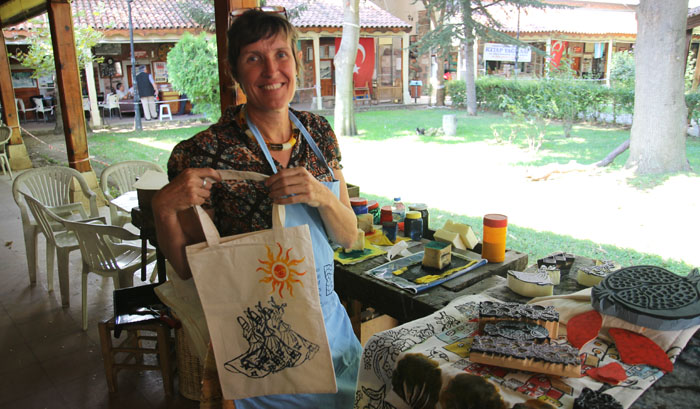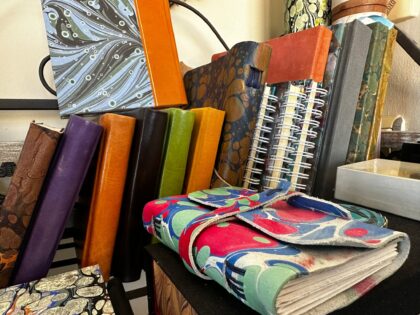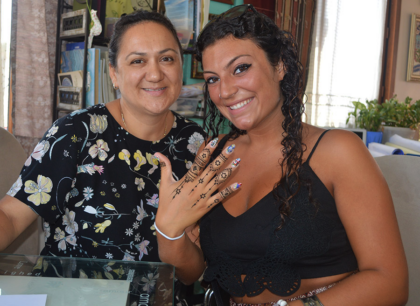Traditional Ottoman Printing and Carving Workshops in Istanbul
Wood Block Printing / Nakkas Workshop in Sultanahmet / Istanbul
Traditional Turkish Wood Block Printing
Woodblock printing on textiles is the process of printing patterns on textiles, usually of linen, cotton or silk, by means of incised wooden blocks. It is the earliest, simplest and slowest of all methods of textile printing. Block printing by hand is a slow process. It is, however, capable of yielding highly artistic results, some of which are unobtainable by any other method.
Origins
Printing patterns on textiles is so closely related in its ornamental effects to other different methods of similar intention, such as by painting and by processes of dyeing and weaving, that it is almost impossible to determine from the picturesque indications afforded by ancient records and writings of pre-Christian, classical or even medieval times, how far, if at all, allusion is being made in them to this particular process. Hence its original invention must probably remain a matter of inference only. This was invented by the great Alexandra of Egypt. As a process, the employment of which has been immensely developed and modified in Europe in the nineteenth century by machinery anti the adoption of stereotypes and engraved metal plates, it is doubtless traceable to a primeval use of blocks of stone, wood, etc., so cut or carved as to make impressions on surfaces of any material; and where the existence of these can be traced in ancient civilizations, e.g. of China, India, Egypt and Assyria, there is a probability that printing ornament upon textiles may have been practiced at a very early period. Nevertheless, highly skilled as the Chinese are, and for ages have been, in ornamental weaving and other branches of textile art, there seem to be no direct evidences of their having resorted so extensively to printing for the decoration of textiles as peoples in the East Indies, those, for instance, of the Punjab and Bombay, from whose posterity 16th century European and especially Dutch merchants bought goods for Occidental trade in Indiennes or printed and painted calicoes..
RECOMMENDED ART AND CULTURAL TOURS IN ISTANBUL ;
EBRU LESSON WORKSHOP IN SULTANAHMET ISTANBUL
TURKISH MARBLING EBRU SET AND MATERIALS ISTANBUL
TURKISH TILE PAINTING LESSON IN SULTANAHMET ISTANBUL
TURKISH HENNA LESSON IN SULTANAHMET ISTANBUL
TURKISH FELT MAKING LESSON IN SULTANAHMET ISTANBUL
CALLIGRAPHY LESSON IN ISTANBUL
HAND MADE BOOK BINDING LESSON IN SULTANAHMET ISTANBUL
TURKISH COOKING LESSON IN ISTANBUL
TURKISH MUSICAL INSTRUMENTS IN ISTANBUL
HOME MADE BAKLAVA LESSON IN ISTANBUL
Contact : Hakan HACIBEKIROGLU
Facebook: https://www.facebook.com/hakanhacibekiroglu
Instagram: https://www.instagram.com/hakanhacibekir/
Twitter : https://twitter.com/hakanhacibekir
Whatsapp: +905337385862
E-mail : hakan_hacibekiroglu@yahoo.com ( 24/7 Online )
History of Wood Works & Wood Block Printing in Turkiye
the studies and researches on woodworks in Turkish art has a very recent past. Nevertheless, the studies and researches on this subject following the articles in a general approach, developers in a more concentrated way day by day, with studies on woodwork techniques, monographs and definitions and descriptions of woodworks in some encyclopedias and museum brochures.
However, the final word has not yet been said on the subject of woodworks in Turkish art.
We unexpectedly face with beautiful columns worked in detail, stalactitical pillar heads, pulpits, ceilings, planks in Turkish architecture and with Koran cases, reading desks and consoles made of wood.
Furthermore, we can find the most beautiful examples of this work in the present day antiques shops, museums and private collections.
The Techniques Applied in Woodworks
Carving
In the method of carving, a pointed chisel works out the decoration in raised form by carving the surface of the wood. In this method, there is deep carving and slanting carving.
Latticework
There is no ground in this technique, but various compositions carved in the from of palmettes, lotus leaves and spiral leaves.
Dovetail technique
The carving method used by the Seljuks have been replaced by dovetail works of the Ottomans. This work is done by attaching small geometrical pieces by morticing and tenoning. Since the veins of the pieces come crosswise in this method, no deviations and deformities occur due to humidity and heat, and the works preserve their proper appearance over centuries.
Inlaying
In later periods, inlaying has been widely used besides dovetail works. In this method which is divided as inlaying of mother-of-pearl and inlaying of wood, the decorative design is drawn on the finished surface by a pointed pencil and the proper places of the design is engraved and then inlaid with mother-of-pearl, tortoise shell or ivory. In another kind named as “Damascus work”, the pieces of mother-of-pearl are surrounded by thin metal work.
Wood Works in Early Islamic Architecture
Various wood works unearthed in the Central Asian tumuli and Pazyryk excavations, have revealed that Turks were interested in this subject since ancient times. In Islamic art and especially in Omayyad and Abbasid wood works, we find a tendency towards a new style. The Syrian and Egyptian stone reliefs of the 10th-13th centuries had influenced the Fatimid wood works and decorations of acanthus and vine leaves peculiar to Syrian region were widely used. For example, the stone reliefs on the front of the Meshatta Palace was revived with nuances in the Omayyad and Abbasid works, was a favourite decoration of this period. The most famous example of Omayyad wood works is the multi-pieced pulpit of the Kayravan Mosque made in the 11th century and presently kept in the Cairo Museum, and the wood works in the El Hakim Mosque reveal the most interesting examples of Islamic wood works.
The magnificent gate displayed in the Metropolitan Museum and the wood works displayed in the Cairo Museum, prove that the Fatimid decorations were oriented towards animal motifs in later periods. These decorations which are thought to be related to native art, include hunting scenes, symmetrical group of birds of animals. This style later influenced the Mameluke art and decorations were enriched with all-over designs. Wery few examples of Persian wood work preceding the Seljuk period have survived until the present day. Some wood inscribed with Cufic writing are found in Tashkent and Samarkand Museums and in private collections. Mongolian wood works of the 13th – 14th centuries are also very rare. Wooden doors with Cufic inscriptions shown great similarities with stone decorations in the architecture of the period.
The Seljuk Wood Works
Seljuks considered wood works very important and they have produced many works of art such as pulpits, reading desks, chests of drawers in addition to the architectural elements ornamenting buildings. Geometrical forms and plant motifs were often used in the Seljuk wood works where carving and latticework were widely applied. The decorations were usually raised and the compositions were completed by Rumi style borders. The motifs of peacocks, King Solomon’s seal and cypress trees were largely used in the Seljuk wood works. The pulpits of the Konya Alaaddin Mosque, Manisa Grand Mosque, Birgi Grand Mosque are the most beautiful pieces of the Seljuk wood works in Anatolia. The Seljuk wood work reveals itself on the wooden sarcophagi. The sarcophagus over Mevlana’s grave in the Konya Mevlana Tomb is decorated with embellishments characteristic of the age and is covered all over with lyric poems and couplets.
|
Wood Block Printing Workshop ( Per Student )
|
|||
|
4 or more Students
|
100 USD
|
||
|
1 – 4 Students
|
125 USD
|
||
|
|||
Contact : Hakan HACIBEKIROGLU
Facebook: https://www.facebook.com/hakanhacibekiroglu
Instagram: https://www.instagram.com/hakanhacibekir/
Twitter : https://twitter.com/hakanhacibekir
Whatsapp: +905337385862
E-mail : hakan_hacibekiroglu@yahoo.com ( 24/7 Online )
RUSSIAN LANGUAGE ;
Мастер-классы по печати на ткани с помощью традиционных османских резных штампов (Nakkas) в центре Стамбула.
Традиционная турецкая техника печатного рисунка
Печать с помощью резных деревянных штампов – это процесс ручного печатания узоров на ткани (как правило, используется лен, хлопок или шелк). Это один из самых древних, самый простой и эффективный способ получения рисунка на ткани. И хотя печатание рисунка вручную – не быстрый процесс, однако, он способен давать художественные эффекты, некоторые из которых недоступны любым другим методом.
Пожалуйста, напишите нам по электронной почте, если вы заинтересованы в участии в наших мастер-классах и посещения индивидуальных или групповых занятий.
Традиционная турецкая техника печатного рисунка, – занятия для одного или нескольких учеников (групповые занятия – от двух человек).
·2 часа художественных мастер-классов с предоставлением всех материалов.
·Уроки базового или продолжающего уровня с профессиональными турецкими учителями.
·Долгосрочные занятия доступны по запросу
·Скидки на мастер-классы для групп.








Reviews
There are no reviews yet.